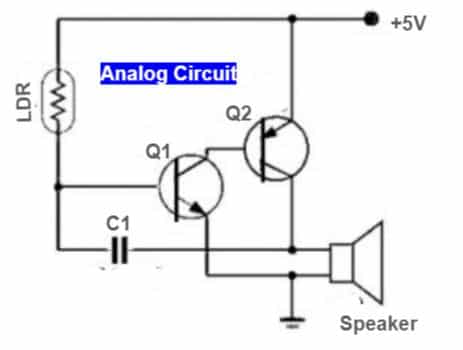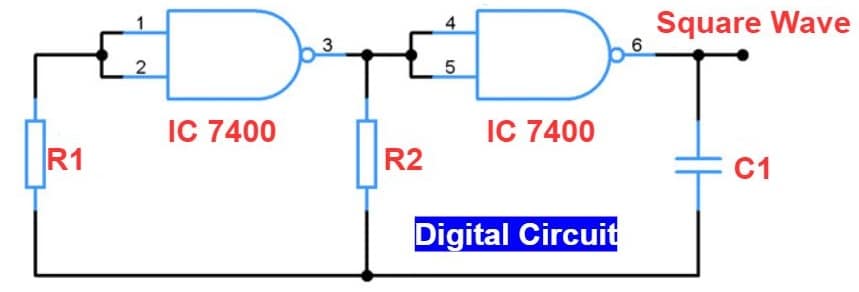In this article, we will discuss the differences between analog circuits & digital circuits. The analog and digital circuits are the basic building block of electronic circuits.
An arrangement of circuit components such as resistors, inductors, capacitors, energy sources, etc. which provides a closed loop for the flow of electric current is known as a circuit or electric circuit.
The excitation in any electrical or electronic circuit is provided by an electric signal, i.e. voltage or current. These electric signals may be of the following two types:
- Analog signals
- Digital signals
An analog signal is one whose magnitude is a continuous function of time, i.e. it varies instantaneously with time. On the other hand, a digital signal is one that is a discrete (or discontinuous) function of time, i.e. a digital signal exists on discrete instants of time.
Based on the type of signals, the electrical and electronic circuits are also classified into two types:
- Analog circuits
- Digital circuits
Now. we will discuss what an analog circuit and digital circuit are and the main differences between them.
What is an Analog Circuit?
An analog circuit is the type of circuit that contains analog circuit elements like resistors, inductors, capacitors, diode, etc., and uses continuous time signal at the excitation and response.

In simple words, an electronic circuit that can process data in analog form is termed an analog circuit. The common examples of analog circuits are voltage dividers, amplifiers, rectifiers, etc.
What is a Digital Circuit?
A type of circuit that has the ability to process digital data is known as a digital circuit. Therefore, the input and output of a digital circuit are in the form of discontinuous time signals.
The digitals are designed by the small electronic circuit components called logic gates. Where the logic gates are able to perform Boolean operations to process the data.

The digital circuits have only two states namely active high and active low, which means they do respond continuously to the input signal. Digital circuits are extensively used in modern electronic devices like computers, calculators, smartphones, power supplies, remote controls, etc.
Difference between Analog and Digital Circuits
The key differences between analog circuits and digital circuits are described in the following table:
| Parameter | Analog Circuit | Digital Circuit |
| Definition | An electronic circuit that is designed to process analog signals is called an analog circuit. | An electronic circuit that is designed to process digital signals is called a digital circuit. |
| Nature of signal used | Analog circuits use signals that are continuous in nature, i.e. continuously vary with time. | Digital circuits use signals that are discontinuous in nature, i.e. discretely vary with time. |
| Circuit components | The circuit components of analog circuits are resistors, inductors, capacitors, diodes, transistors, etc. | The major components of the digital circuit are logic gates like AND, OR, NOT, NAND, etc. |
| Design complexity | Analog circuits involve complex design because there are limited design tools available. | Due to the availability of automated and many design tools, it is easy to design digital circuits. |
| Response / states | Analog circuits instantaneously respond to the input signal. Thus, it has an excitation state at every instant of time. | Digital circuits respond to the input signal discretely. Hence, it has only two states namely active high (On) and active low (Off). |
| Need for signal conversion | There is no need for conversion of the analog signal into digital and vice-versa in the case of analog circuits. | A Digital circuit requires the conversion of analog signals into digital for process and then digital signals into analog for measuring or outputting. |
| Interaction with the physical world | In the physical world, signals are analog in nature. Therefore, the analog circuits can interact with the outside world directly. | A digital circuit cannot directly interact with the physical world, it needs the conversion of the outside analog signal into a digital signal first. |
| Loss of information | There is no loss of information in the case of analog circuits. It is because they do not need a signal transformation from one form to another. | During signal transformation, some information may be distorted in the digital circuits. |
| Sensitivity | Analog circuits are more sensitive to changes in the signal. | Digital circuits are comparatively less sensitive. |
| Immunity to noise | Analog circuits are less immune to electronic noise. | Digital circuits are relatively more immune to electronic noise. |
| Power requirement | Analog circuits require more power to function. | Digital circuits consume less power. |
| Accuracy | The accuracy of analog circuits is less. | Digital circuits are relatively more accurate. |
| Need of triggering signal | Analog circuits do not need trigger (or clock) signals to be active and synchronized. | Digital circuits require triggering or clock signals to be active and synchronized. |
| Applications | Analog circuits are used in data communication, radio stations, power transmission, rectification, etc. | Digital circuits are used in switching applications and digital electronic devices like computers, calculators, microcontrollers, etc. |
Summary
We have discussed all the fundamental differences between analog circuits and digital circuits by considering various parameters. One major difference between the two circuits is that the analog circuit functions with continuous time functions, while the digital circuit functions with discontinuous time signals.